#Nanofabrication
Text
Shrinking the World: Unveiling the Top-Down vs. Bottom-Up Battle in Nanofabrication
Demystify top-down vs. bottom-up approaches in nanofabrication & explore the exciting potential of non-lithographic techniques shaping the future!
Imagine shrinking yourself down to the size of a grain of rice and entering a world where materials behave differently, where properties like strength, conductivity, and reactivity change dramatically at the nanoscale. This is the fascinating realm of…

View On WordPress
0 notes
Text

𝐍𝐚𝐧𝐨𝐦𝐚𝐭𝐞𝐫𝐢𝐚𝐥𝐬: Nanoscience focuses on understanding the properties and behavior of nanomaterials, which can exhibit unique properties due to their small size and high surface area.
𝐈𝐧𝐭𝐞𝐫𝐝𝐢𝐬𝐜𝐢𝐩𝐥𝐢𝐧𝐚𝐫𝐲 𝐍𝐚𝐭𝐮𝐫𝐞: Nanoscience and nanotechnology draw from multiple disciplines, including physics, chemistry, biology, engineering, and materials science, to explore phenomena at the nanoscale.
Visit @ https://symbiosisonlinepublishing.com/nanoscience-technology/
#nanoscience#technology#nanosciencetech#nanostructures#nanometerscales#transmissionelectronmicroscopy#nanoscalematerials#nanomedicine#carbondots#nanofabrication#nanolithography#photonics#Macroscope#spintronics#nanomotor#insulintherapy#molecularmachine#nanodevices#journal#journals#pubmed#peerreview#peerreviewed#OpenAccess#openaccessjournal#symbiosisonlinepublishing
1 note
·
View note
Text
3D Nanofabrication Market to Grow at a CAGR of 27.4% during 2020 to 2028; Quince Market Insights
0 notes
Text
Construction Drone
I lay on the conveyor belt, strapped to it. In preparation for this journey, we had been stripped naked, and all of our hair had been removed by some gel-like substance. And even when washed off, the gel gave our skin a strange unearthly sheen. Then, they injected us with some chemicals. What it was, we didn’t know. But I felt like I was starting to enter a trance-like state.
With a sharp jerk, the belt began to move. Staring straight upwards, motionless, I could only see the lights overhead, and the beams of the cold industrial interior passing by. We stopped at the first station, and the robotic arms mounted at it whirred to life. I felt, distantly, something being done to my limbs. I was only vaguely aware of any sensations. Mostly, I only felt the feeling in my shoulder that my arm was moving. We proceeded to the next station, and I felt similar sensations in my hip. I rotated my head slowly to see what might have been done.
If I hadn’t been sedated, I would’ve said it was a shock. My left arm ended above the elbow, ending in a shiny metallic port. By the feeling, I could tell they had done the same to the right. The next few stations worked on my four limb’s ports, machinery plugging in and detaching, twisting, fusing machinery together. Every now and then there was a spark.
An eyepiece came down and was pressed against my face, attaching to the nodes which had formed around my eye. It sealed with a click, and the curved domed interior perfectly cupped the surface of my eye. It was cold, like the feeling when you first put eyedrops in. It then painlessly penetrated the pupil and made contact directly with the optic nerve. When the eyepiece powered on, it was like my human vision blinked out of existence- replaced with something larger and more detailed. Enhanced. I felt a helmet cup my head, sealing itself. Circular dome-like pieces went over the ears and filled them, and I heard a sound as the earpiece’s surprisingly-soft (silicone?) mechanism brushed against the eardrum. It was all so tight. A robotic arm swiveled around and welded the eyepiece and earpieces to the helmet.
We stopped at the last station. There were strange sensations in my crotch although it was almost completely numb; Pressure, as I could tell there were changes being made there. This continued for some time. A little bit of fear broke through my trance state. After the machines withdrew, I looked to see what had been done: There was a big silver port that seemed to go a couple inches into me. The connector I assume was for not just connecting the waste collection system, but for both reading and stimulating nerve impulses for pleasure.
The conveyor belt started rotating downward so that I was in almost a standing pose, a few feet off of the ground. A heavy mechanized exoskeleton stood, ready for its occupant, the shoulder and chest plating open to allow me to fit inside. I was lowered into it, slowly. It was soft inside, and I sunk into the nanofabric. There were clicking and whirring sounds as the port above my knees docked with the leg port inside the exoskeleton. A couple seconds later, the same occurred with my elbow ports.
The suit’s soft interior then began to inflate until it was tight, like a blood pressure machine but squeezing my entire body. After it was frighteningly tight for a few seconds, it suddenly relaxed so that I was held in the suit but not uncomfortable.
I stood in the suit, a couple feet higher than I did before I was modified as the double-jointed legs were longer than a human’s. The armor surrounding me was boxy, yellow, and made of cold thick steel. It had various panels and warnings written in writing and illustrations: Warning: “Keep minimum 12 foot radius clearance while unit is in operation”. Cautionary symbols for the chemicals contained in the unit. The company logo was emblazoned on the side in a stark, simple font which the company thought might look futuristic. Black caution stripes lined some parts of the limbs. The two arms were equally large and bulky: suitable for a construction mech. One ended in a large clamp-like robotic hand, and the other an array of tools. The legs were double-jointed with thick shock absorbers and large pistons. Thick hydraulic hoses connected all of these limbs, gasketed to the back of my new robot body. The abdomen was made up of reinforced darker-colored overlapping and segmented metal strips. All kinds of heavy support servos hid beneath them. Something akin to a rollbar was welded to my frame, right above where my backpack-like structure was mounted.
Two workers approached and connected hoses to the side of my abdomen. For each one, they would place the metal ring of the tube’s end against my jack, then twist, locking it into place. Sometimes they would give it a tug to make sure it is secure. I then heard gurgling sounds as my various fluid storage tanks were filled for the first time. Hisses as the oxygen tanks filled. One worker swung up the crotch-plating, its metal cylindrical connector docking with my crotch jack as it swung upwards and inside, loudly clamping into place. It made the necessary connections. I gasped. It felt.. good. It then swung the buttplating closed, which also latched to the rest of the exoskeleton. It penetrated me, sealing me into the suit. I would have no need to leave it.
One of the workers swung down the shoulder guards while the other swung the chestplating up. They all clamped together, locking around me with loud clacking sounds, one at a time, spaced at about two a second. Now for the last two pieces.
The worker raised the mouthpiece that was attached to the suit in front of me, and I opened my mouth. He inserted it, and I bit down. It fed its tube down my throat, and with a hiss the oxygen mask activated. Then the other inserted a large tube going from the exoskeleton into the jack on the back of my head. As he inserted it, it felt like it went into my mind. I felt like my entire visual and audio glitched a few times. I had the sensation of a system booting up inside me, and inside my suit. One of the workers inserted a fuel cell into my backpack. It opened an adjacent panel and flipped the switch inside, then latched it shut again. When he hit the switch, I instantly felt a jolt in the exoskeleton. Then, a few seconds later, I could feel dull vibrations around me as the suit powered on and came to life.
I walked forward a few steps. Large, lumbering. With each step, I could feel the crotch and butt implants inside of me. I felt detached; removed. Most of my body could not feel much encased in this soft nanofabric, the world on the other side of inches of heavy steel. Each step made a loud but dull thump as the heavy rubber soles slammed against the floor, being driven into the surface by a two ton cyborg drone.
I stopped in the middle of the room. Two arms lowered from the ceiling and grabbed onto either side of my rollbar, and began to lift me straight up. It then began moving me forward, along a track, my heavy cybernetic body dangling awkwardly, limp. Eventually, we came to a small room packed with other construction cyborgs, just inches from each other’s heavy-duty mechanical bodies. It appeared to be some kind of shipping container. I was lowered down into the one remaining slot. My feet slid into place and were clamped down so that we wouldn’t move during the journey.
Then my hydraulic systems shut off, the motors winding down, the limbs rigidly locking into place. The only system still running were the vitals.
And then they lowered the lid onto the shipping container we were in. The light disappeared. Soft mechanical clicking and hissing noises of the life support system buried deep inside each mech were the only noises we could now hear. We were ready to be shipped out and activated for our first assignment.
260 notes
·
View notes
Text
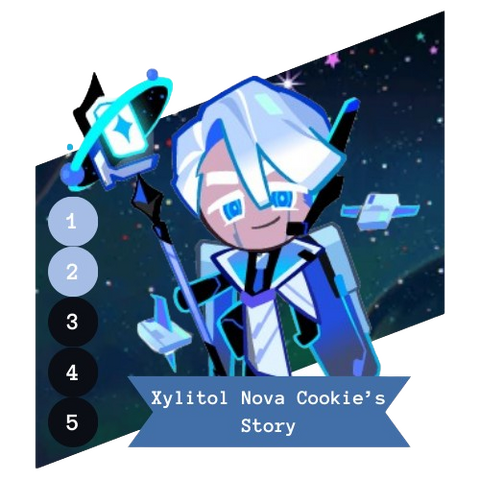
Chapter two: Baby feathers
READ HERE
Chapter 2 of Xylitol Nova cookies backstory with his son is now released! Please enjoy first few paragraphs under the cut!
It had been a few months now since Xylitol Nova Cookie had taken Electrolyte Cookie as his son, and in that time, they had spent likely only an hour or two apart from each other. Even now, as he walked through the halls of the engineering wing, he still had his child secured to his chest with a comfortable nanofabric harness, and a pouch at his side that contained anything that young Electrolyte could need.
He was possibly the most attentive father this side of the Galaxy, and all of his people, Cookies and Robots alike, knew it. He hummed joyfully to himself as he walked down the alloy flooring, waving and smiling to every Cookie and robot he saw.
Eventually, he found himself in the hanger bay for the new fleet of Ranger ships, to which he had been requested to oversee and assist in their welding and assembly. He had passed his beloved child over to Professor Xylitol Gray, whom gently bounced and cooed to Electrolyte as Nova oversaw the construction
As well as his child, he had also set his coat aside as well, leaving him in his tie and form-fitting black turtleneck, as he continued to work on assisting some of the Robots in making the correct welds. Suddenly, his work was interrupted when he heard a familiar cry ring out in the air. The one Electro always made when he was hungry! He smiled, as he glanced at a nearby digital clock.
“2:45pm Exact… Right on time as always, aren't you…”
Nova joked to himself, as he put down his tools, and walked over to Professor Gray, as she took a bottle from the pack that Nova had set aside, and prepared it for Electrolyte.
“Never thought you'd be such a great father, Sir..” Professor Gray said to Nova, as he refused to have the robot tend to Electro, instead picking him up, and caring for him himself.
"Of all the years we've known you, you never once made any indication of wanting to adopt, or start a family… If you could bother an old Cookie's curiosity.. What changed?" Professor Gray said curiosity.
Nova hesitated. Despite all the time he had spent raising his son, most people simply just offered congratulations, and didn't question his decisions. Gray might have been the first to possibly ask so outright…
Continue reading here
#milkys art#cookie run kingdom#cookie run#xylitol nova cookie#electrolyte cookie#crk#crob#cookie run ovenbreak#crk oc#crob oc#cookie run oc
17 notes
·
View notes
Text
The Finances of Cyberpunk Dystopia
The dazzling neon lights, gritty streets, and high-tech innovations painted in the cyberpunk landscape have always been an intoxicating visual. But if you peel away the layers, you'll find a core deeply rooted in economic disparity, corporate overreach, and alternative financial systems. This genre, encapsulated in books, TV shows, films, games, and anime, has often painted a dystopian view of future financial systems. Let’s delve into the intricate details of these economic portrayals.
Corporate Currency and Credits
One of the most prominent themes in cyberpunk is the omnipresence of mega-corporations. These entities have grown so influential that they have their own currencies, rendering national currencies obsolete. Think of the Eurodollars in "Cyberpunk 2077", or the corporate credits in "Neuromancer". These universal credits are often digital and can be traded, earned, and stolen, not too dissimilar to cryptocurrencies today.
Cryptocurrencies and Digital Assets
Many cyberpunk tales, like Neal Stephenson's "Snow Crash", hint at decentralized digital currencies. In these narratives, individuals rely on these currencies for anonymous transactions. With the rise of Bitcoin and other cryptocurrencies, this vision seems closer to reality than fiction. Cryptocurrencies represent a decentralized, peer-to-peer financial system where transactions are recorded on a blockchain, away from the prying eyes of governmental institutions.
Bounty Systems
With the decline of conventional law enforcement in some cyberpunk depictions, there's a rise in privatized justice. This includes bounty systems where individuals or groups are paid to enforce laws or hunt down criminals. "Altered Carbon" and "Cowboy Bebop" both provide glimpses into such a world. While bounty hunting has historical precedents, its heightened prevalence in a tech-driven world could be a potential future scenario, especially with the privatization of many sectors.
Barter and Trade Systems
In a world where digital surveillance is rampant, going off-grid and relying on barter becomes appealing. Some cyberpunk stories show characters trading goods and services directly, without the need for a standardized currency. This throwback to ancient economic systems is a form of resistance against corporate and state surveillance.
Resource-Based Economy
Some stories, like those in the "Eclipse Phase" game, depict a future where humanity has moved beyond the constraints of money. Instead, resources are allocated based on need and sustainability. This post-scarcity economy is often made possible by advanced technologies like nanofabricators, which can produce almost any item on-demand. While it sounds utopian, it raises questions about value, motivation, and societal organization.
Which Are Most Likely?
Given the rapid advancement of technology, especially in the finance sector, the notion of cryptocurrencies and digital assets seems to be the most probable. We're already witnessing a shift towards digital transactions and the rise of decentralized finance (DeFi).
Corporate currencies, on the other hand, while possible, would require an immense concentration of power in the hands of a few entities - a scenario which many governments would likely resist. As for bounty systems, while privatized law enforcement is a possibility, it's one many would hope remains fiction.
The beauty of the cyberpunk genre is its ability to reflect our societal concerns and amplify them. Whether it's a cautionary tale or a speculative future, these financial landscapes provoke thought and inspire debate about the direction in which we're headed.
- REV1
34 notes
·
View notes
Text
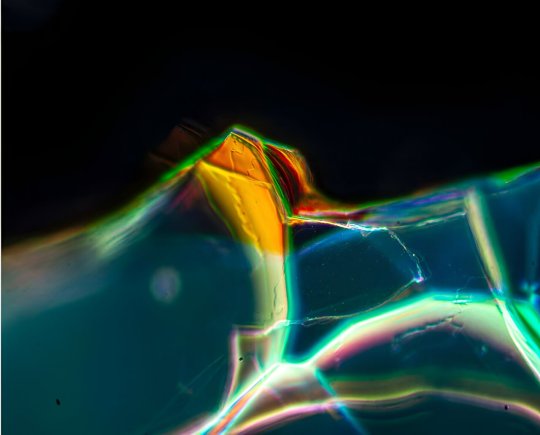
Scientists discover nanofabrication of photonic crystals on buried ancient Roman glass
Some 2,000 years ago in ancient Rome, glass vessels carrying wine or water, or perhaps an exotic perfumes, tumble from a table in a marketplace, and shatter to pieces on the street. As centuries passed, the fragments were covered by layers of dust and soil and exposed to a continuous cycle of changes in temperature, moisture, and surrounding minerals.
Now these tiny pieces of glass are being uncovered from construction sites and archaeological digs and reveal themselves to be something extraordinary. On their surface is a mosaic of iridescent colors of blue, green and orange, with some displaying shimmering gold-colored mirrors.
These beautiful glass artifacts are often set in jewelry as pendants or earrings, while larger, more complete objects are displayed in museums.
Read more.
#Materials Science#Science#Photonics#Crystals#Nanotechnology#Science history#Glass#Iridescence#Tufts University
38 notes
·
View notes
Note
Ok I'm sending a lot of asks lately and I can cool it if you want but I just realized. Rubicon mentioned the Mortal Reverie having (multiples of) a device called a "quantum printer", which can be used in some way to make complex technology like communications receivers. It's a cool tidbit but I can't find any other mention of quantum printers elsewhere, it's not on the wiki or anything
It's not a commonly mentioned piece of Halo lore, no. There's an ooooold reference to something like a space future 3d printer that apparently dates back to the i love bees arg (which is kinda sketchy lore ground by today's standard) though:
Basically, 3d printing technology wasn't a thing when Halo was invented and so it sounds like the kind of thing they're back-filling into the lore because the scifi should have it now. I kind of wish they wouldn't, Halo's vibe was already retrofuturistic when Halo CE came out, but I'm not in charge.
That said, the Covenant and Forerunners have had nanomachine assembly tech in their lore for years now so I guess fair's fair.
7 notes
·
View notes
Text
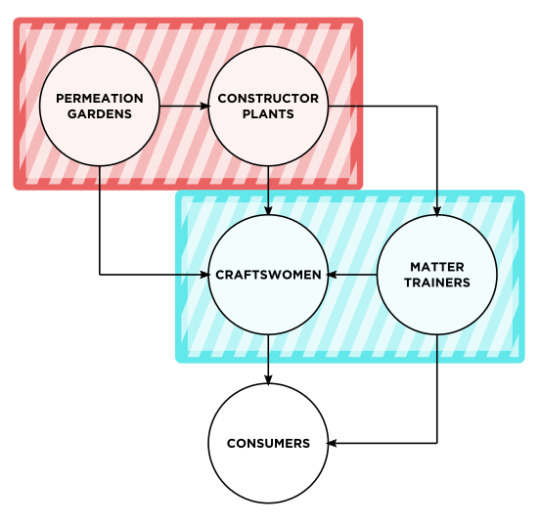
A flowchart showing the approximate flow of goods within the Affini's gift-based economy. Red indicates heavy industries, while blue indicates light industries.
Permeation Gardens are large artificial forests (including interdependent fungi and insects) that leach desired minerals out of the landscape with minimal disruption to the geography. Wide, deep root structures search for mineral veins and slowly separate trace amounts from rocks and soil.
Constructor Plants are genetically-modified flora that take in and process industrial materials such as metals or chemicals. An Affini operator is usually grafted into the Constructor when it is in operation, guiding the complex metabolic processes required in modern heavy industry, though some simple tasks can be performed autonomically. Most constructor plants produce yield in the form of sap or fruit, but some also shed bark or vitrify directly into structural components.
Matter Trainers are a nanofabrication technology used by the Affini to manufacture cheap, disposable items like medical supplies and hygine products. They are sealed cabinets of differing sizes in which swarms of nano-scale assembler robots assemble objects at the molecular scale, drawing raw feedstock from communal stores. Almost all Affini homes and public spaces have at least one Trainer, usually tucked away somewhere unobtrusive yet accessible. Larger (more than 1m in any dimension) trainers are usually kept in public workshops. The biggest trainers are the size of space stations, and usually have their own crew and propulsion.
When it comes to non-disposable items such as clothes, personal electronics, furniture, etc. most Affini consumers prefer goods handmade by craftswomen, rather than matter trainers. Objects can be tailored to an individual's needs and tastes, rather than suffering the one-size-fits-all approach common to most trainer designs. Whether the object is made from scratch or manufactured with the help of a trainer depends on the item being produced and the craftswoman making it. For every Affini blacksmith making artisinal walking sticks from raw ore, there is another woman hand-painting canes from a trainer in bright floral patterns.
6 notes
·
View notes
Text
1/24/2024
First research experience with university faculty! Literally just got a research advisor TODAY omggg. I'll be working on nano-photolithography and nanofabrication! So basically, it's really really small 3-D printing with an incredibly high resolution. So excited! Still don't know all the details but I'm ready to be in the lab!
1/30/2034 update:
so apparently we're doing work with nano-optics and plasmonics i cant waitttt!
2 notes
·
View notes
Text
As per tradition, I continue to turn my silly little vrchat avatar retextures into actual characters. Meet Ilmarinen (left) and Domovoi (right)!

Ilmarinen is a mantled beast with a mastery in programmable matter and nanofabrication. They wound up in a universe that was hesitant to form complex structures, so they decided to take the matter into their own hands, building an interstellar-scale art gallery for any extradimensional patrons who happen to wander in.
Domovoi is a plush avali who lost a lot of information about their old universe upon splitting from Jupiter's consciousness. Fortunately, his new home universe is incredibly cozy, making it a popular destination for multiversal travelers; sometimes, another DromaeOS unit comes by and tells him about the civilization they were once part of.
#furry sfw#furry art#scifi art#avali#mantled beast#nanites#oc art#vrchat avatar#worldbuilding#lore#plushie#furry#furry oc#anthro#anthro art#clean furry
5 notes
·
View notes
Text
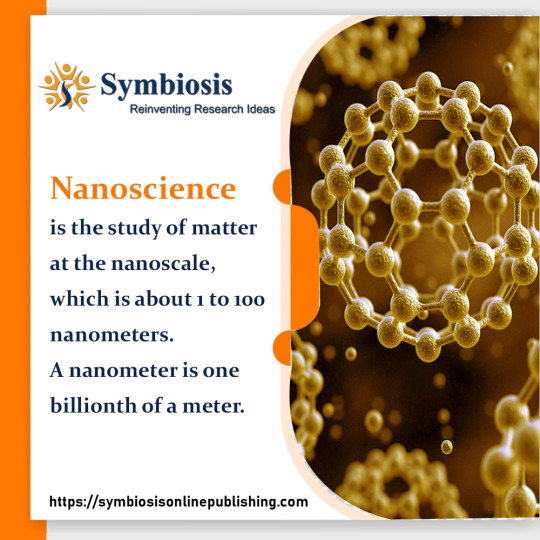
𝐇𝐞𝐚𝐥𝐭𝐡𝐜𝐚𝐫𝐞: Nanoparticles can be used to deliver drugs to specific parts of the body, to diagnose diseases, and to create new medical devices.
𝐄𝐧𝐞𝐫𝐠𝐲: Nanotechnology can be used to create new solar cells, batteries, and fuel cells.
𝐈𝐧𝐟𝐨𝐫𝐦𝐚𝐭𝐢𝐨𝐧 𝐭𝐞𝐜𝐡𝐧𝐨𝐥𝐨𝐠𝐲: Nanotechnology can be used to create new computer chips, sensors, and displays.
Visit: https://symbiosisonlinepublishing.com/nanoscience-technology/
#nanoscience#technology#nanosciencetech#nanostructures#nanometerscales#transmissionelectronmicroscopy#nanoscalematerials#nanomedicine#carbondots#nanofabrication#nanolithography#photonics#Macroscope#spintronics#nanomotor#insulintherapy#molecularmachine#nanodevices#Nanotoxicity#nanoparticles#Nanobiosensors#nanopharmaceuticals#journal#journals#pubmed#peerreview#peerreviewed#OpenAccess#openaccessjournal#symbiosisonlinepublishing
0 notes
Text
Nano-Enhanced Hydrogels for Probing Cellular Mechanotransduction
KU Leuven
Are you interested in an interdisciplinary PhD? Join us to explore dynamic cell-ECM interactions using advanced microscopy and nanoparticles!
See the full job description on jobRxiv: https://jobrxiv.org/job/ku-leuven-27778-nano-enhanced-hydrogels-for-probing-cellular-mechanotransduction/?feed_id=76128
#biophysics #fluorescence_microscopy #microrheology #nanofabrication #soft_matter_physics_fluid_dynamics #ScienceJobs #hiring #research
0 notes
Text
A review of pharmaceuticals removal from water resources using magnetic iron-based nanomaterials
Nyakairu, G. W. A., & Shehu, Z. (2024). “A review of pharmaceuticals removal from water resources using magnetic iron-based nanomaterials.” Nanofabrication, 9. https://doi.org/10.37819/nanofab.9.1797
Abstract
The presence of pharmaceuticals in water resources is a growing concern worldwide due to their potential health impacts on aquatic life and humans. Therefore, there is a need to develop…
View On WordPress
0 notes
Text
New MIT.nano equipment to accelerate innovation in “tough tech” sectors
A new set of advanced nanofabrication equipment will make MIT.nano one of the world’s most advanced research facilities in microelectronics and related technologies, unlocking new opportunities for experimentation and widening the path for promising inventions to become impactful new products.
The equipment, provided by Applied Materials, will significantly expand MIT.nano’s nanofabrication…
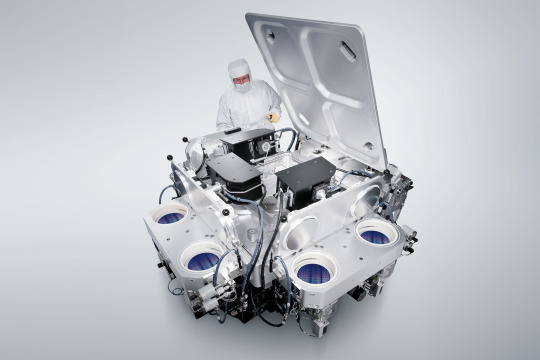
View On WordPress
0 notes
Text
Fuze Technology receives updated EPA approval for antimicrobial, product lifetime durability
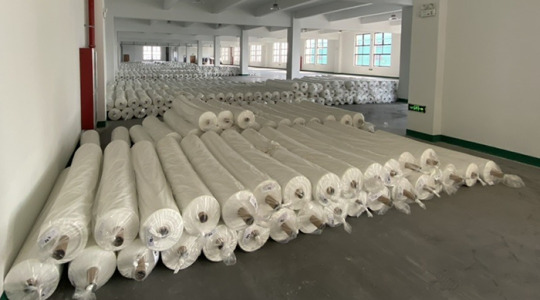
Fuze Technology (Fuze) announced today the Environmental Protection Agency’s (EPA) registration and approval for its products used in textiles and surfaces for antimicrobial effects, as well as the lifetime durability of its application.
“This is huge news for Fuze and for the textiles industry,” said Andrew Peterson, Fuze CTO. “The EPA has reviewed our product and verified that it is an antimicrobial that is retained by the fabric for more than 100 washes. That is a first in the industry,” he continued.
The EPA’s approvals uniquely position Fuze in the market, making Fuze the only antimicrobial that can last the life of the textile it is applied to. Fuze uses its patented process to create its products that are applied to fabrics using various application methods.
In addition to its antimicrobial features, Fuze’s technology leads with its chemical-free, anti-odor capabilities which also promote moisture wicking and significantly faster drying times, while not disrupting the fabrics look or feel.
“Remarkably, we achieve these benefits using just 1mg per kilo of textile—a dosage nearly 1 million times less than any other antimicrobial treatments currently available,” Peterson mentioned. “This ultra-low application rate not only ensures minimal environmental impact but also maintains fabric integrity and performance over time,” he continued.
Fuze is a wholly owned subsidiary of EVŌQ Nano a nanoscience company that engineers novel nanoparticles for the life science, materials science, and textile science industries. The company’s multi-patented, high-volume laser nanofabrication process creates nanoparticles that are uniformly sized, surfactant-free, with consistent spherical morphology, and no ion emissions under standard and stressed conditions. These properties represent a significant advancement in nanoscience with the potential for a wide range of applications. To learn more, visit fuze47.com.
0 notes